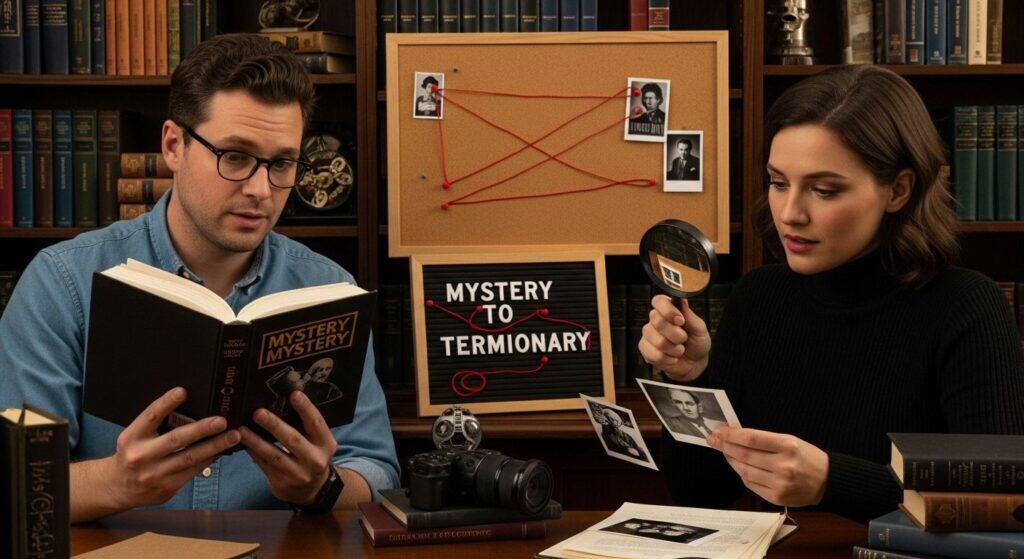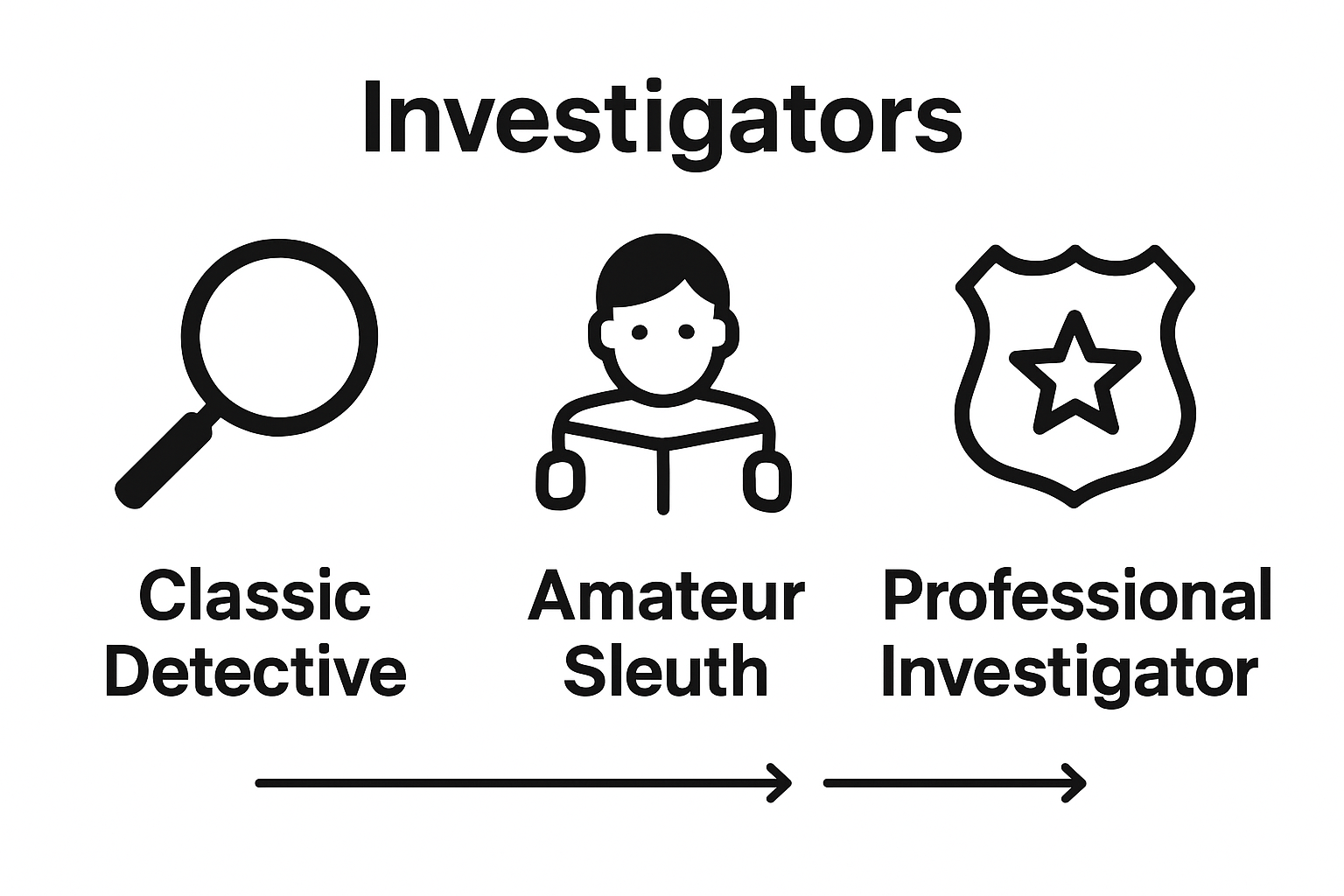Understanding Mystery Fiction Terminology Explained

Mystery fiction pulls readers in with puzzles, hidden clues, and the thrill of unraveling secrets. Yet for all the clever twists and dramatic reveals, the magic often lies in the hidden mechanisms behind the story. Did you know that understanding terms like red herring and locked room mystery can actually make you a better reader and help you solve stories faster? Most fans think mystery is just about finding out whodunit. However, once you master the genre’s secret vocabulary, each turn of the page becomes a stimulating challenge that transforms the way you see every clue.
Table of Contents
- Defining Mystery Fiction: Key Terms And Their Significancen
- The Structure Of Mystery Stories: Common Elements Explained
- Character Types In Mystery Fiction: Roles And Functions
- Plot Devices Unique To Mystery Fiction: What To Know
- Why Understanding Terms In Mystery Fiction Enhances Enjoyment
Quick Summary
| Takeaway | Explanation |
|---|---|
| Understanding core elements enhances enjoyment. | Identifying key components like central mysteries helps deepen reader engagement with mystery narratives. |
| Character archetypes drive narrative complexity. | Different investigative characters add unique perspectives, enriching the psychological exploration of the mysteries. |
| Familiarity with plot devices enhances critical thinking. | Recognizing techniques like red herrings and closed circles challenges readers to actively engage with and analyze the story. |
| Active reading improves overall experience. | Readers who engage with specialized terminology gain more satisfaction and understanding from the narrative complexity. |
| Narrative structure builds suspense effectively. | Understanding how stories escalate tension and resolve conflicts enhances the appreciation for mystery fiction’s intricate plots. |
Defining Mystery Fiction: Key Terms and Their Significancen
Mystery fiction represents a captivating narrative genre where intellectual curiosity and suspenseful storytelling converge. Understanding its fundamental terminology provides readers with deeper insights into the intricate world of detective stories, crime novels, and investigative narratives.
The Core Elements of Mystery Fiction
At its essence, mystery fiction revolves around a central enigma or crime that demands resolution. Explore our comprehensive guide to mystery genres to understand how different narrative structures interact with this fundamental premise. The genre typically involves several critical components that distinguish it from other storytelling formats:
- A central puzzle or crime that drives the narrative
- A protagonist who investigates or seeks resolution
- Progressive revelation of clues and information
- Intellectual challenge for both characters and readers
Narrative Techniques and Character Archetypes
Mystery fiction employs sophisticated narrative techniques designed to engage readers while maintaining suspense. According to academic research in literary studies, successful mystery narratives balance information revelation with strategic concealment. The protagonist often represents a specific archetype:
- The classic detective: Analytical, methodical, with exceptional observational skills
- The amateur sleuth: Accidentally drawn into investigation, often driven by personal motivation
- The professional investigator: Systematic, trained in solving complex cases
These archetypes provide different perspectives on solving the central mystery, offering readers varied intellectual and emotional experiences. Each character type brings unique problem-solving approaches, transforming the narrative from a simple crime story into a complex exploration of human psychology and reasoning.
Understanding these terminological nuances helps readers appreciate the genre’s intricate storytelling mechanisms, transforming reading from mere entertainment into an intellectual journey of discovery and deduction.
The Structure of Mystery Stories: Common Elements Explained
Mystery stories follow a meticulous narrative structure that systematically builds tension, introduces complexity, and ultimately provides satisfying resolution. These carefully crafted narratives are more than simple storytelling they are intricate puzzles designed to challenge and engage readers intellectually.
The Classic Narrative Progression
Uncover the secrets of mystery storytelling through understanding its fundamental structural components. According to narrative research from literary scholars, mystery stories typically unfold through a precise sequence:
- Introduction of the Central Mystery: Establishing the fundamental problem or crime
- Initial Investigation: First attempts to understand the underlying issue
- Escalating Complications: Introduction of unexpected twists and potential red herrings
- Critical Revelation: Breakthrough moment where significant information emerges
- Final Resolution: Comprehensive explanation and closure of the narrative puzzle
Architectural Components of Mystery Narratives
Each mystery story operates like an intellectual machine, with specific mechanical components working together to create narrative momentum. The plot architecture typically involves strategic placement of clues, deliberate information withholding, and carefully managed revelations.
Crucial narrative elements include:
- Foreshadowing: Subtle hints that provide context without revealing the complete solution
- Misdirection: Intentional narrative strategies that temporarily mislead the reader
- Character Motivations: Complex psychological underpinnings that drive the investigative process
The most compelling mystery stories transform seemingly disconnected information into a cohesive, surprising narrative that rewards careful reader attention. By maintaining a delicate balance between revealing and concealing information, these stories create an immersive intellectual experience that keeps readers engaged until the final revelation.
Character Types in Mystery Fiction: Roles and Functions
Character types in mystery fiction are not merely narrative participants but intricate narrative instruments carefully designed to advance the plot, challenge reader expectations, and contribute to the overall investigative experience. Each character serves a specific strategic purpose within the complex machinery of mystery storytelling.

Primary Investigative Figures
Discover the intricate world of detective characters and their nuanced roles in narrative construction. According to academic research in literary archetypes, investigative characters represent more than simple problem solvers:
- The Classic Detective: Analytical, methodical, with exceptional deductive reasoning
- The Amateur Sleuth: Accidentally entangled in investigation, driven by personal curiosity
- The Professional Investigator: Systematic, trained in forensic and investigative techniques
Supporting Character Dynamics
Beyond primary investigative figures, mystery narratives populate their worlds with characters who serve critical narrative functions. These supporting roles create narrative tension, provide critical information, and challenge the protagonist’s investigative process.
Key supporting character archetypes include:
- The Suspect: Potentially responsible for the central crime, often with complex motivations
- The Witness: Possesses crucial information that might reveal or obscure the truth
- The Red Herring: Intentionally misleading character designed to misdirect investigative focus
These character types interact in a sophisticated dance of revelation and concealment, transforming mystery fiction from simple crime narratives into complex psychological explorations. Their interactions create narrative layers that engage readers intellectually, challenging them to discern truth from misdirection while maintaining suspenseful storytelling momentum.
To clarify the primary character archetypes in mystery fiction and their distinguishing features, here is a comparison table you can reference while reading mystery stories.
| Character Type | Defining Traits | Narrative Role |
|---|---|---|
| Classic Detective | Analytical, methodical, keen observer | Leads investigations, solves core mystery |
| Amateur Sleuth | Untrained, curious, personally motivated | Accidentally entangled in crime-solving |
| Professional Investigator | Trained, systematic, evidence-focused | Applies official procedures to investigations |
| Suspect | Ambiguous motives, potentially deceptive | Provides tension, possible perpetrator |
| Witness | Holds crucial or obscured information | Offers clues, can direct or mislead inquiry |
| Red Herring | Intentionally misleading character | Distracts both reader and investigator |
Plot Devices Unique to Mystery Fiction: What to Know
Mystery fiction employs a sophisticated arsenal of narrative techniques that transform storytelling into an intellectual puzzle. These plot devices are not mere storytelling tricks but carefully engineered mechanisms designed to challenge reader expectations and create intricate narrative experiences.
Classic Narrative Manipulation Techniques
Explore the art of mystery storytelling and uncover the strategic devices that define the genre. According to research in narrative construction, these plot devices serve multiple narrative functions:
- Closed Circle of Suspects: Limiting potential culprits to a specific group
- Red Herring: Deliberately misleading narrative elements
- MacGuffin: Plot catalyst that drives action but may be ultimately insignificant
- Unreliable Narrator: Creating narrative uncertainty through subjective storytelling
Structural Complexity in Mystery Narratives
Mystery fiction plot devices operate as intricate narrative mechanisms, each serving a specific purpose in constructing intellectual engagement. These techniques transform storytelling from linear progression to a complex puzzle that demands active reader participation.
Key structural devices include:
- Locked Room Mystery: Presenting seemingly impossible crime scenarios
- Reverse Chronology: Revealing story elements in non linear sequence
- Multiple Perspective Narration: Providing fragmented narrative insights
These devices create a sophisticated intellectual experience, challenging readers to become active participants in the investigative process. By strategically withholding and revealing information, mystery fiction turns narrative consumption into an engaging mental exercise that rewards careful attention and analytical thinking.
This table outlines the most common plot devices and structural elements unique to mystery fiction, explaining their narrative function and purpose.
| Plot Device/Structure | Description | Primary Purpose |
|---|---|---|
| Closed Circle of Suspects | Limits potential culprits to a defined group | Increases suspense and focus |
| Red Herring | Misleading clue or character | Distracts from the true solution |
| MacGuffin | Object/event driving story, often inconsequential | Propels plot and investigation |
| Unreliable Narrator | Perspective distorts or withholds truth | Heightens suspense and uncertainty |
| Locked Room Mystery | Crime appears impossible within physical limits | Presents complex puzzle for reader |
| Reverse Chronology | Reveals plot in non-linear order | Builds intrigue through puzzle assembly |
| Multiple Perspective | Uses different viewpoints to fragment information | Offers varied clues, increases complexity |
Why Understanding Terms in Mystery Fiction Enhances Enjoyment
Mystery fiction is not merely a genre of entertainment but an intellectual engagement that rewards readers who develop a nuanced understanding of its specialized language and narrative conventions. By mastering the terminology, readers transform from casual observers to active participants in the storytelling process.
Cognitive Engagement Through Terminology
Discover the secret language of mystery stories and unlock a deeper reading experience. According to academic research in reader comprehension, understanding genre specific terminology significantly enhances reader enjoyment:
- Pattern Recognition: Identifying narrative structures and clue placement
- Predictive Reading: Anticipating potential plot developments
- Critical Analysis: Evaluating narrative complexity and author strategies
- Emotional Investment: Feeling more connected to the investigative process
The Intellectual Reward of Genre Literacy
Terminological knowledge transforms reading from a linear experience into an interactive intellectual challenge. Readers who understand concepts like red herring, MacGuffin, and unreliable narrator can decode narrative strategies with greater sophistication.
Key intellectual benefits include:
- Developing more advanced comprehension skills
- Appreciating subtle narrative techniques
- Experiencing a more immersive storytelling experience
- Gaining deeper satisfaction from solving narrative puzzles
By learning the specialized language of mystery fiction, readers become more than mere consumers of stories they become skilled interpreters of complex narrative architectures, finding profound enjoyment in the intellectual dance between author and audience.

Put Your Mystery Know-How Into Action With Fast, Addictive Stories
You just explored the secrets behind mystery fiction terminology. If you find yourself intrigued by how detectives analyze clues or enjoy tackling a well-placed red herring, you are ready for a hands-on experience. Maybe you crave the satisfaction of unraveling a story’s puzzle but do not want to commit to an endless novel. If terms like locked room mystery or unreliable narrator spark your curiosity, you deserve stories that match your pace and your intellect. Discover short mystery reads that transform your understanding of the genre.

Put your fascination into practice with TheShortReads.com. Download a FREE short fiction story now and jump into smartly crafted mysteries anytime you have a break. Our library is designed for busy readers and newcomers who prefer meaningful stories under 150 pages. If you want to recognize the classic detective in action, spot clever misdirections, or simply savor a quick twist ending, now is the perfect time to start. Download your first free short mystery at TheShortReads.com, and see how easily reading can fit into your life.
Frequently Asked Questions
What is mystery fiction?
Mystery fiction is a genre of storytelling that revolves around a central enigma or crime that needs to be solved, combining elements of suspense and intellectual engagement for both readers and characters.
What are the main elements of mystery fiction?
Main elements include a central puzzle or crime, an investigator, progressive revelation of clues, and an intellectual challenge that keeps readers engaged until the resolution.
What are common character types in mystery stories?
Common character types include the classic detective, amateur sleuth, professional investigator, suspects, witnesses, and red herrings, each playing distinct roles in advancing the plot.
Why is understanding terminology in mystery fiction important?
Understanding terminology enhances the reading experience by allowing readers to recognize narrative structures, anticipate plot developments, and appreciate the complexity of the storytelling.
Recommended
Article generated by BabyLoveGrowth
Share